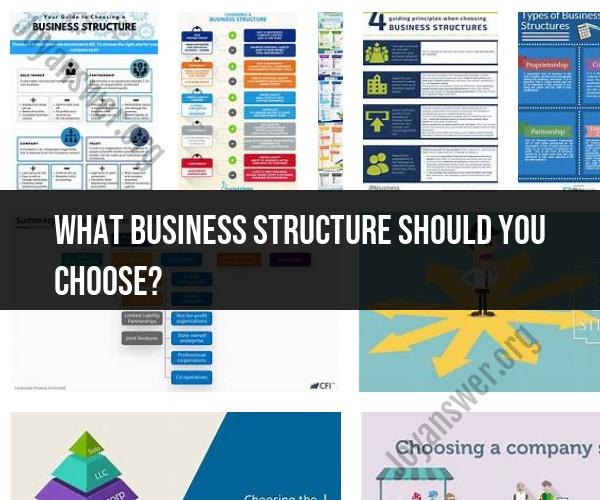What business structure should you choose?
Choosing the right business structure is a crucial decision that will impact various aspects of your business, including taxes, liability, management, and ownership. The choice you make should align with your business goals, size, industry, and individual circumstances. Here's a comprehensive guide to help you decide which business structure is right for you:
Sole Proprietorship:
- Ownership: Sole proprietorships have a single owner.
- Liability: The owner has unlimited personal liability, meaning personal assets are at risk if the business incurs debts or legal issues.
- Taxation: Business income is typically reported on the owner's personal tax return (Schedule C).
- Management: The owner has full control and decision-making authority.
- Ease of Setup: Easy and inexpensive to establish.
- Suitable For: Small, low-risk businesses with a single owner who wants complete control.
Partnership:
- Ownership: Partners (two or more individuals or entities) jointly own the business.
- Liability: Partners share personal liability for the business's debts and legal issues.
- Taxation: Partnerships are pass-through entities, and profits are reported on partners' personal tax returns.
- Management: Partners typically share management responsibilities.
- Ease of Setup: Relatively easy to form, with a partnership agreement outlining roles, responsibilities, and profit-sharing.
- Suitable For: Businesses with multiple owners who want to share ownership, management, and profits.
Limited Liability Company (LLC):
- Ownership: Owners are called members, and there can be one or multiple members.
- Liability: Members generally have limited personal liability, protecting their personal assets from business debts.
- Taxation: LLCs can choose to be taxed as a partnership, corporation, or sole proprietorship, depending on their needs.
- Management: Flexibility in management structure, can be managed by members or designate a manager.
- Ease of Setup: Moderately easy to form, with fewer regulatory requirements than corporations.
- Suitable For: Small to medium-sized businesses looking for liability protection and flexibility in taxation and management.
C Corporation:
- Ownership: Shareholders own the corporation through ownership of stock.
- Liability: Shareholders have limited liability, and their personal assets are generally protected.
- Taxation: C corporations are subject to double taxation—profits are taxed at the corporate level, and dividends are taxed at the individual level.
- Management: Managed by a board of directors and officers elected by shareholders.
- Ease of Setup: More complex and costly to establish than sole proprietorships, partnerships, or LLCs.
- Suitable For: Larger businesses seeking access to capital through stock issuance, with plans for significant growth.
S Corporation:
- Ownership: Shareholders, like in a C corporation, but with specific limitations on the number and types of shareholders.
- Liability: Shareholders have limited liability.
- Taxation: S corporations are pass-through entities, meaning profits and losses flow through to shareholders' personal tax returns, avoiding double taxation.
- Management: Managed similarly to C corporations, with a board of directors and officers.
- Ease of Setup: Similar setup complexity to C corporations, but with restrictions on eligibility.
- Suitable For: Small to medium-sized businesses that want limited liability and tax advantages while avoiding double taxation.
Nonprofit Corporation:
- Ownership: Governed by a board of directors, with no ownership or shareholders in the traditional sense.
- Liability: Directors and officers typically have limited liability.
- Taxation: Eligible for tax-exempt status, meaning they do not pay federal income tax on certain income.
- Management: Managed by a board of directors or trustees.
- Ease of Setup: Involves additional regulatory and filing requirements compared to for-profit structures.
- Suitable For: Organizations with a charitable, religious, educational, or social mission.
Cooperative (Co-op):
- Ownership: Owned and democratically controlled by its members, who share in profits or benefits.
- Liability: Members generally have limited liability.
- Taxation: Taxation varies by type (consumer, worker, etc.) and location, but co-ops may have tax advantages.
- Management: Managed democratically by members or through elected representatives.
- Ease of Setup: Involves setting up membership agreements and bylaws, can vary in complexity.
- Suitable For: Groups of individuals or businesses with a common interest or need who want a cooperative ownership and decision-making structure.
When choosing a business structure, consider factors such as liability protection, taxation, management preferences, and your long-term business goals. Consulting with a legal or financial advisor is often wise to ensure you make an informed decision that suits your specific circumstances. Additionally, the business structure you choose may have legal and tax implications, so it's essential to comply with local regulations and tax laws.
Choosing the Right Business Structure: Factors to Consider
When choosing a business structure, there are a number of factors to consider, including:
- Liability protection: Some business structures, such as corporations and limited liability companies (LLCs), offer personal liability protection to their owners. This means that the owners' personal assets are not at risk if the business is sued or goes bankrupt.
- Taxation: Different business structures are taxed differently. For example, sole proprietorships and partnerships are taxed as pass-through entities, meaning that the business income is passed through to the owners and taxed on their individual tax returns. Corporations, on the other hand, are taxed as separate entities.
- Ownership structure: Some business structures, such as corporations, allow for multiple owners and shareholders. Others, such as sole proprietorships, only allow for one owner.
- Management structure: Some business structures, such as corporations, have a formal management structure with a board of directors and officers. Others, such as sole proprietorships, do not have a formal management structure.
Business Structure Options: Making the Right Choice for Your Company
The most common business structures are:
- Sole proprietorship: A sole proprietorship is a business owned and operated by one person. It is the simplest and least expensive business structure to set up, but it offers no personal liability protection.
- Partnership: A partnership is a business owned and operated by two or more people. Partnerships can be general partnerships or limited partnerships. General partners have unlimited personal liability, while limited partners have limited personal liability.
- Limited liability company (LLC): An LLC is a hybrid business structure that offers the personal liability protection of a corporation and the tax advantages of a pass-through entity.
- Corporation: A corporation is a separate legal entity from its owners. Corporations offer the strongest personal liability protection, but they are also the most complex and expensive business structure to set up.
Legal Structures: Selecting the Best Fit for Your Business
The best business structure for your company will depend on your specific needs and circumstances. If you are unsure which business structure to choose, it is a good idea to consult with an attorney or accountant.
Here are some general guidelines for choosing a business structure:
- If you are a single-owner business and you are not concerned about personal liability protection, then a sole proprietorship may be the best option for you.
- If you are a single-owner business and you are concerned about personal liability protection, then an LLC may be the best option for you.
- If you have multiple owners and you are concerned about personal liability protection, then an LLC or corporation may be the best option for you.
- If you are planning to raise capital from investors or if you want to take your company public, then a corporation may be the best option for you.
It is important to note that you can change your business structure at any time, but there may be tax and legal implications involved.













